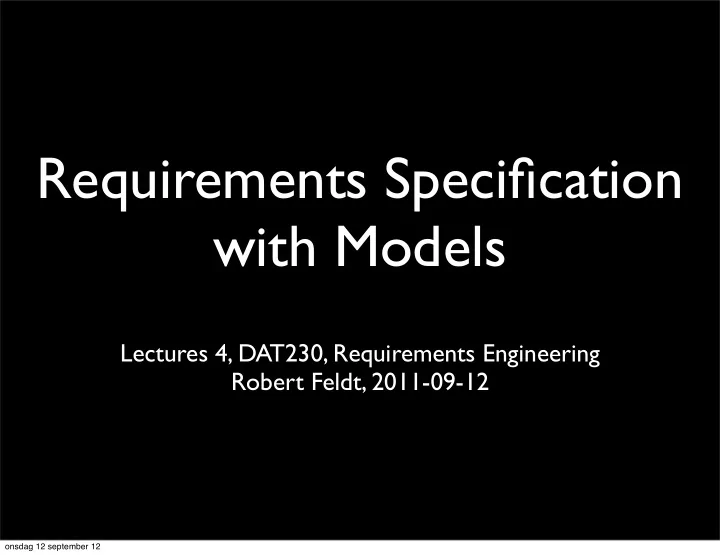

Requirements Specification with Models Lectures 4, DAT230, Requirements Engineering Robert Feldt, 2011-09-12 onsdag 12 september 12
Recap • Elicitation to find/gather/create/refine/specify reqs & understand stakeholder needs • Many different elicitation techniques • Interviews, Group sessions, Observation are key • Always: care, be human, listen, focus on them, glossary • Other sources: Docs, Strategies, Problem domain, History, Competitors, Environment • Different abstraction levels • Structured interview more powerful than open-ended onsdag 12 september 12
A continuum /Modeling & Specification onsdag 12 september 12
What is Req Specification? onsdag 12 september 12
What is Req Specification? “The deliberate documentation of requirements to a degree that makes the associated risks tolerable” onsdag 12 september 12
What is Req Specification? “The deliberate documentation of requirements to a degree that makes the associated risks tolerable” i.e. writing requirements down in a form so that we avoid later problems onsdag 12 september 12
What is Req Modeling? onsdag 12 september 12
What is Req Modeling? “The construction of abstract descriptions of reqs/goals/systems/behavior” onsdag 12 september 12
What is Req Modeling? “The construction of abstract descriptions of reqs/goals/systems/behavior” Used in several RE activities: elicitation, analysis, specification onsdag 12 september 12
What are risks without doc? • Reqs still ambiguous & open-ended after elicitation => • Developers make decisions/assumptions later => • User <-> Dev difference: User not satisfied • Dev <-> Dev difference: Inconsistent system • Overall: Costs high! • BUT: • Goal is ideal PRODUCT not ideal Req Doc! • Thus: Just enough Req Spec to reduce Risks! onsdag 12 september 12
Cost-effectiveness “Common sense” Customers/Users Developers SRS Doc onsdag 12 september 12
Cost-effectiveness “Common sense” Customers/Users Developers SRS Doc onsdag 12 september 12
Cost-effectiveness “Common sense” Customers/Users Developers SRS Doc onsdag 12 september 12
Cost-effectiveness “Common sense” Customers/Users Developers SRS Doc onsdag 12 september 12
Roles of Req Doc • Communication device between all parties • Customers, Marketing, Sales, Finance, Management, Devs, Testers • Drives design and choices • Drives testing • Drives project management • Basis for evolution / releases onsdag 12 september 12
Specification Techniques Word doc Scenario State transition Use case Excel doc diagram Storyboard DB / Req tool Stimulus-response UML state diagram sequence Interaction- / Text State-based Sequence-based Decision tables Decision trees Text UI standards PLanguage Volere Prototype Decision-based Sketches Probabilistic Look’n’feel Quality Patterns samples CSP Z VDM Quality User Property-based Requirements Interfaces Formal onsdag 12 september 12
Selecting techniques • Stakeholders must understand => Natural Language • Models where NatLang has risks: • Complex interactions/sequences/states/decisions • Interfaces • BUT not “One model to rule them all!” • Quality requirements: • Quantify • Capture in structured english or PLanguage onsdag 12 september 12
Industrial survey: Methods for ReqEng? Uses... “Yes” Reviews of requirements 63.8% Model-based development 25.0% Prototype-based development 24.3% Prioritization of reqs 23.7% Personas for req elicitation 20.4% UML 17.8% Modeling/formalisms for reqs 11.8% Software Product Lines 5.9% 152 answers from Swedish industry, Spring 2009 onsdag 12 september 12
Tool for Req Eng work? Svarade Andel Office (Word, Excel, Visio) 23.8% None 15.3% Requisite Pro 10.2% Quality Center 9.6% Don’t know 5.1% Focal Point / DOORS 4.0% Caliber 3.4% Customer-specific 3.4% RSA 3.4% Clear Case 3.4% Req Test 3.4% Rest / Other (max 2 mentions per tool) 18.6% 177 tools mentioned in total onsdag 12 september 12
Goal-driven Req Specification [Kavakli2003] onsdag 12 september 12
I* • http://www.cs.toronto.edu/km/istar/ • Models Agents and their Intentions • Early Req Specification together with Customers • 1. Strategic Dependency Model • Actors and Dependencies • Certain Actions performed by certain Actors • Ex: User depends on system to open door to meet goal to enter building • 2. Strategic Rationale Model • Looks inside actors, what drives them onsdag 12 september 12
I* example onsdag 12 september 12
KAOS Goal modeling and refinement [Betrand1998] onsdag 12 september 12
KAOS Goal modeling and refinement [Betrand1998] onsdag 12 september 12
KAOS Goal modeling and refinement [Betrand1998] onsdag 12 september 12
Data modeling: E-R Diagrams [Wikipedia2012] onsdag 12 september 12
Data modeling: E-R Diagrams [Wikipedia2012] onsdag 12 september 12
Formal languages: Z • Mathematical language for describing computing system • Model-based, models abstract data type (ADT) • ADT = system state and operations on it • State = state variables and their values • Operation = can change state • Good match to imperative programming languages • Also extension for OO languages; form of inheritance • Very mature, used since 1970’s onsdag 12 september 12
State Transition Diagram (Z example) From J. Jacky, “The way of Z”, chapter 6 onsdag 12 september 12
State Transition Table (Z example) onsdag 12 september 12
And now in Z onsdag 12 september 12
References [Kavakli2003] Kavakli, E. and Loucopoulos, P ., “Goal driven requirements engineering: evaluation of current methods”, Proceedings of the 8th CAiSE/ IFIP8, pp. 16-27, 2003. [Bertrand1998] Darimont, R. and Delor, E. and Massonet, P . and Van Lamsweerde, A., “GRAIL/KAOS: an environment for goal-driven requirements engineering”, ICSE conference, pp. 612-620, 1997. onsdag 12 september 12
Recommend
More recommend